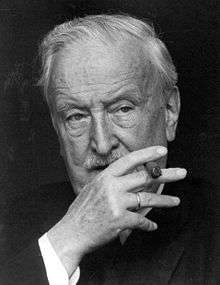Hermann Josef Abs

Hermann Josef Abs (15 October 1901 – 5 February 1994)[1] was a German banker. He was a member of the board of directors of Deutsche Bank from 1938 to 1945, as well as of 44 other companies,[2] including IG Farben. As the most powerful commercial banker of the Third Reich, he was, according to economic journalist Adam LeBor, "the lynchpin of the continent wide plunder".[3] The Allies arrested him as a suspected war criminal on 16 January 1946, however British intervention got him freed after three months despite a detailed report that would be published later.[2] After World War II (1957–1967) he was chairman of Deutsche Bank, and contributed to the reconstruction of the German economy.
Legacy
Cultural legacy
Conceptual artist Hans Haacke created a work in 1974 called Manet-PROJEKT '74, which was supposed to be displayed in the Wallraf-Richartz-Museum.[4] Manet-PROJEKT '74 was a "ten-panel work about the turbulent and surprising fate of a painting by Édouard Manet, Bunch of Asparagus (1880), as it passed through the hands of its various owners before being bought for the Wallraf-Richartz-Museum by an acquisition committee of the museum's friends. Every temporary owner of the painting was presented, along with their biographical data, including that of the Chairman of the committee, the German banker Hermann J Abs, who had played a key role in the economic design and stabilization of Nazism. Such biographical details had tended to be suppressed in the post-war period, but Haacke had only to go the Bonn University library to dig them up".[4]
In a six-by-eight meter room, Bunch of Asparagus (1880) was to have been positioned on a studio easel juxtaposed with panels hung on the wall presenting "the social and economic position of the persons who have owned the painting over the years and the prices paid for it".[5]
Horst Keller, the director of the Wallraf-Richartz-Museum, "objected to listing Hermann J. Abs' nineteen positions on the board of directors".[6] "Given that most of the previous owners of the Manet ... had been Jewish ... the revelation of Abs' past provided a cultural-historical twist with considerable impact. Under pressure from the Director of the museum (presumably in the interest of Abs, who, as the post-war chairman of Deutsche Bank for many years, was still extraordinarily influential), the curators were forced not to admit Haacke's work to the exhibition".[4]
Abs was a powerful financier, who helped the museum purchase the work; he was on the board of directors; he was a Friend of the Museum; at the time he was honorary president and member of Deutsche Bank's advisory board.[7][4] On 15 February 1928 he married Inez Schnitzler, coming from a reputable Cologne family. They had two children.
References
- ↑ "Abs, Hermann J.". Who Was Who in America, 1993-1996, vol. 11. New Providence, N.J.: Marquis Who's Who. 1996. p. 1. ISBN 0837902258.
- 1 2 Wistrich, Robert (27 April 2016). Who's Who In Nazi Germany (third ed.). Routledge. pp. 1–2. ISBN 1138171557.
- ↑ LeBor, Adam (28 May 2013). Tower of Basel: The Shadowy History of the Secret Bank that Runs the World. PublicAffairs. ISBN 161039254X.
- 1 2 3 4 Walter Grasskamp, Hans Haacke, Phaidon Press, 54
- ↑ Hans Haacke, Unfinished Business, 118
- ↑ Benjamin Buchloh, Obra Social, 79
- ↑ Hans Haacke, Unfinished Business, 130
Other sources
- Hermann J. Abs, in Encyclopædia Britannica online
- Obituary: Hermann Abs